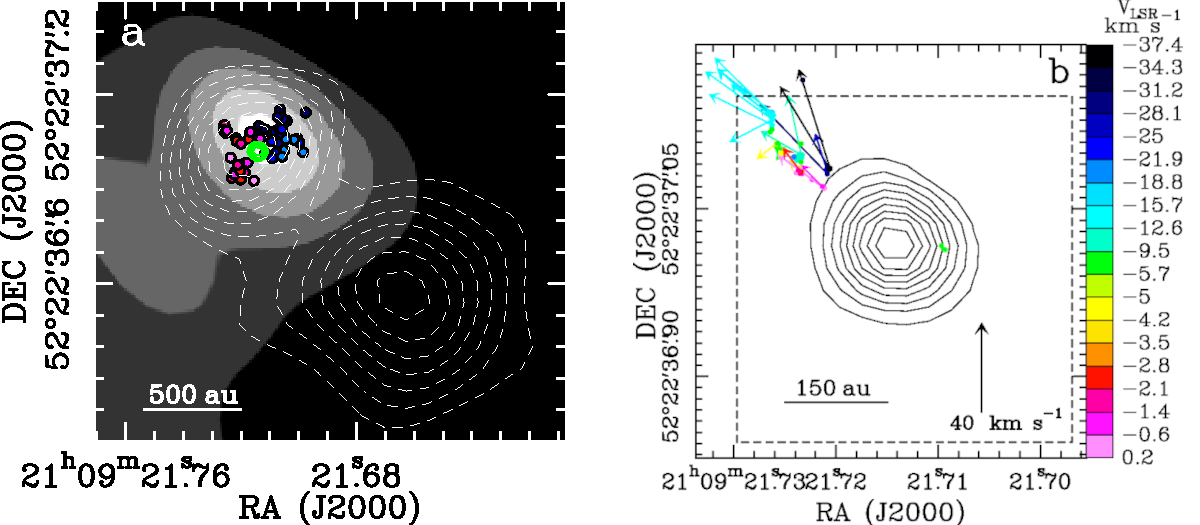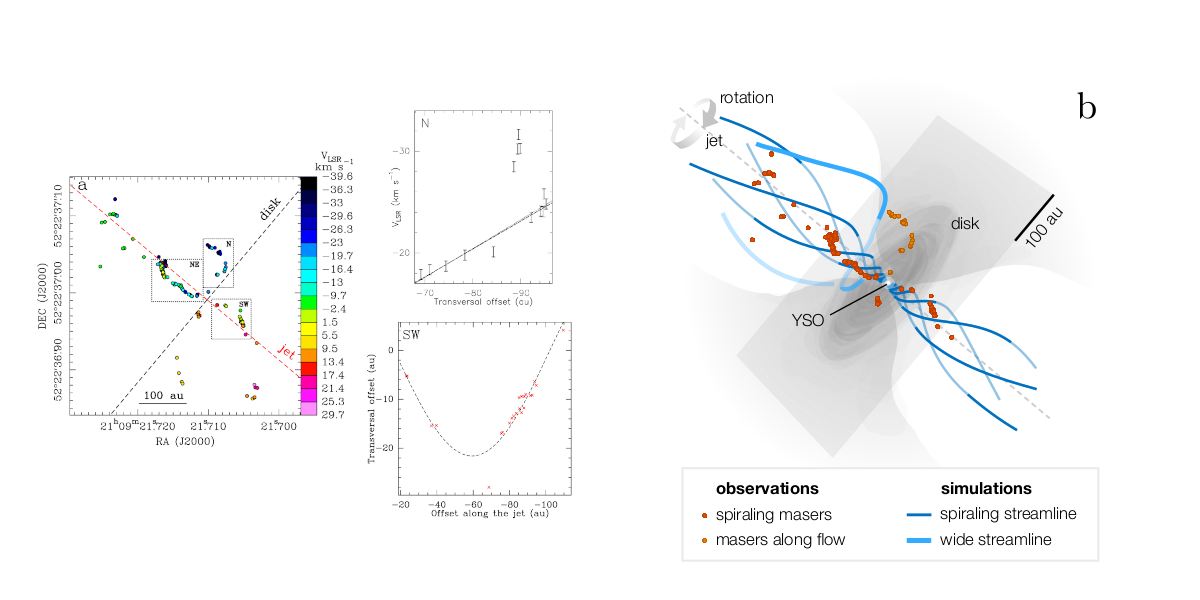
Snapshot of a magnetohydrodynamic disk wind traced by water maser observations
by Luca Moscadelli (INAF-Osservatorio Astrofisico di Arcetri, Italy) on behalf of co-authors of the paper

The formation of astrophysical objects of different nature and size, from black holes to gaseous giant planets, involves a disk-jet system, where the disk drives the mass accretion onto a central compact object and the jet is a fast collimated ejection along the disk rotation axis. Magnetohydrodynamic (MHD) disk winds (DW) (Blandford et al., 1982; Pudritz et al., 1983) have been proposed to account for the link between mass accretion and ejection, which is essential to ensure that the excess angular momentum is removed from the system and accretion onto the central object can proceed. So far, the best observational evidence for a MHD DW towards several low- (Lee et al., 2017) and few high-mass (Hirota et al., 2017) young stellar objects (YSO) has been the finding, through high-angular resolution Atacama Large Millimeter Array (ALMA) observations, of line-of-sight velocity gradients transversal to the YSO's jet axis, which are interpreted in terms of jet rotation and the imprint of the magneto-centrifugal acceleration. However, that is indirect evidence and the derivation of key parameters, as the launch radius and the magnetic lever arm, can be seriously affected by systematic biases (Tabone et al., 2020).
Recently, sensitive global VLBI observations of the 22 GHz water masers toward the intermediate luminosity, 5x103 L⊙, and mass, 5.6 ± 2 M⊙, YSO IRAS 21078+5211 (see Figure 1) have resolved, for the first time, the kinematics of a MHD DW on length scales of 1-100 au (Moscadelli et al., 2022). On scales of a few 100 au, by employing the NOrthern Extended Millimeter Array (NOEMA), a rotating disk is observed in high-density molecular tracers (CH3CN and HC3N, see Figure1a). Interferometric observations at radio wavelengths (5 cm) using the Jansky Very Large Array (JVLA) have revealed a jet directed NE-SW (PA ≈ 44o) emerging from the YSO, whose position at the center of the disk is pinpointed by compact thermal emission observed with the JVLA at 1.3 cm. During 2010-2011 we have performed multi-epoch Very Long Baseline Array (VLBA) observations of the water maser emission at 22 GHz. These observations have discovered a cluster of masers placed ≈100 au NE from the YSO, whose proper motions are collimated NE-SW (PA = 49o) and trace the base of the jet from the YSO (see Figure 1b). The analysis of the three-dimensional (3D) maser motions, specifically the local standard of rest (LSR) velocity gradient transversal to the jet axis and the constant ratio between the toroidal and poloidal velocities, suggested that the jet could be launched from a MHD disk wind.
Figure 2a shows the water maser distribution from the novel (October 2020), sensitive global VLBI observations of the 22 GHz water masers toward IRAS 21078+5211. The water masers are mainly found within 100 au from the YSO and trace magnetised streams of gas emerging from the YSO's disk (see Figure 2b). Specifically, close to the disk rotation axis, in the SW and NE regions, the masers trace sinusoidal patterns in the plane of the sky (see Figure 2SW), which are univocal signatures of a spiralling motion along the jet axis. At larger separation from the rotation axis, in the N region, the maser LSR velocity changes linearly with the radial distance (till reaching the Alfvèn point, see Figure 2N), which indicates that the maser stream co-rotates with its launch point from the disk as predicted by magneto-centrifugal acceleration. This interpretation is supported by (resistive-radiative-gravito-) MHD simulations of the formation of a star starting from the gravitational collapse of a rotating cloud core threaded by a magnetic field. In these simulations, a magneto-centrifugally launched jet (see Figure 2b) develops around the forming star which has properties matching many features of the maser and thermal (continuum and line) observations of IRAS 21078+5211.

References
Blandford et al. 1982, MNRAS 199 883; Hirota et al. 2017, Nature Astronomy 1 146; Lee et al. 2017, Nature Astronomy 1 152; Moscadelli et al. 2022, Nature Astronomy 6 1068; Pudritz et al. 1983, ApJ 274 677; Tabone et al. 2020, A&A 640 A82.
Published in Moscadelli et al. 2022, Nat Astron 6, 1068–1076